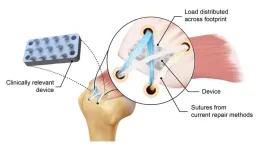(Press-News.org) Researchers at Baylor College of Medicine, the University of Cambridge in the U.K. and collaborating institutions have shown that serotonin 2C receptor in the brain regulates memory in people and animal models. The findings, published in the journal Science Advances, not only provide new insights into the factors involved in healthy memory but also in conditions associated with memory loss, like Alzheimer’s disease, and suggest novel avenues for treatment.
“Serotonin, a compound produced by neurons in the midbrain, acts as a neurotransmitter, passing messages between brain cells,” said co-corresponding author Dr. Yong Xu, professor of pediatrics – nutrition and associate director for basic sciences at the USDA/ARS Children’s Nutrition Research Center at Baylor. “Serotonin-producing neurons reach out to multiple brain regions including the hippocampus, a region essential for short- and long-term memory.”
Serotonin communicates messages to brain cells by binding to receptors on the cell surface, which signal the receiving cell to carry on a certain activity. In this study, the Xu lab, with expertise in basic and genetic animal studies, and the human genetics lab of co-corresponding author Dr. I. Sadaf Farooqi, professor of metabolism and medicine at the University of Cambridge, focused on serotonin 2C receptors, which are abundantly present in the brain’s ventral hippocampal CA1 region (vCA1), investigating the role of the receptor in memory in humans and animal models.
“We had previously identified five individuals carrying variants of the serotonin 2C receptor gene (HTR2C) that produce defective forms of the receptor,” Farooqi said. “People with these rare variants showed significant deficits on memory questionnaires. These findings led us to investigate the association between HTR2C variants and memory deficits in animal models.”
The team genetically engineered mice to mimic the human mutation. When the researchers ran behavioral tests on these mice to evaluate their memory, they found that both males and females with the non-functional gene showed reduced memory recall when compared with the unmodified animals. “When we combined the human data and the mouse data, we found compelling evidence connecting non-functional mutations of the serotonin receptor 2C with memory deficits in humans,” Xu said.
The animal models also enabled the team to dig deeper into how the receptor mediates memory. They discovered a brain circuit that begins in the midbrain where serotonin-producing neurons are located. These neurons project to the vCA1 region, which has abundant serotonin 2C receptors. “When neurons in the midbrain reaching out to neurons in the vCA1 region release serotonin, the neurotransmitter binds to its receptor signaling these cells to make changes that help the brain consolidate memories,” Xu said.
Importantly, the researchers also found that this serotonin-associated neural circuit is damaged in a mouse model of Alzheimer’s disease. “The neural circuit in the Alzheimer’s disease animal model cannot release sufficient serotonin into the vCA1 region that would need to bind to its receptor in the downstream neurons to signal the changes required to consolidate a memory,” Xu said.
However, it is possible to bypass this lack of serotonin and directly activate the downstream serotonin receptor by administering a serotonin analog, lorcaserin, a compound that selectively activates the serotonin 2C receptor in these cells. “We tested this strategy in our animal model and were excited to find that the animals treated with the serotonin analog improved their memory,” Xu said. “We hope our findings encourage further studies to evaluate the value of serotonin analogs in the treatment of Alzheimer’s disease.”
Other contributors to this work include Hesong Liu, Yang He, Hailan Liu, Bas Brouwers, Na Yin, Katherine Lawler, Julia M. Keogh, Elana Henning, Dong-Kee Lee, Meng Yu, Longlong Tu, Nan Zhang, Kristine M. Conde, Junying Han, Zili Yan, Nikolas A. Scarcelli, Lan Liao, Jianming Xu, Qingchun Tong, Hui Zheng, Zheng Sun, Yongjie Yang, Chunmei Wang and Yanlin He. The authors are affiliated with one of the following institutions: Baylor College of Medicine, Texas Children’s Hospital, University of Cambridge, University of Texas Health Science Center at Houston and Louisiana State University.
See the publication for the sources of financial support for this work.
###
END
Serotonin 2C receptor regulates memory in mice and humans – implications for Alzheimer’s disease
2024-06-28
ELSE PRESS RELEASES FROM THIS DATE:
New device inspired by python teeth doubles strength of rotator cuff repairs
2024-06-28
New York, NY—June 24, 2024—Most people, when they think about pythons, visualize the huge snake constricting and swallowing victims whole. But did you know that pythons initially hold onto their prey with their sharp, backward-curving teeth? Medical researchers have long been aware that these teeth are perfect for grasping soft tissue rather than cutting through it, but no one has yet been able to put this concept into surgical practice. Over the years, mimicking these teeth for use in surgery has been a frequent topic ...
The beginnings of fashion
2024-06-28
EMBARGO: 4:00 Sydney AEST June 29 | 14:00 US ET June 28 2024
The beginnings of fashion
Paleolithic eyed needles and the evolution of dress
A team of researchers led by an archaeologist at the University of Sydney are the first to suggest that eyed needles were a new technological innovation used to adorn clothing for social and cultural purposes, marking the major shift from clothes as protection to clothes as an expression of identity.
“Eyed needle tools are an important development in prehistory because they document a transition in the function of clothing from utilitarian to social purposes,” says Dr Ian Gilligan, Honorary Associate ...
Why some tumors are resistant to cell therapies
2024-06-28
FRANKFURT. In congratulating the CARISMa scientists, Goethe University President Prof. Enrico Schleiff said: “The new LOEWE network sets up in Hesse an innovative research program that is currently gathering steam all over the world. It also expands Goethe University’s existing research profile and broadens our network of cooperation partners in the field of CAR cell therapy [editor’s note: CAR is the abbreviation for chimeric antigen receptor]. The network deliberately builds on our university’s ...
Can A.I. tell you if you have osteoporosis? Newly developed deep learning model shows promise
2024-06-28
Osteoporosis is so difficult to detect in early stage it’s called the “silent disease.” What if artificial intelligence could help predict a patient’s chances of having the bone-loss disease before ever stepping into a doctor’s office?
Tulane University researchers made progress toward that vision by developing a new deep learning algorithm that outperformed existing computer-based osteoporosis risk prediction methods, potentially leading to earlier diagnoses and better outcomes for patients with osteoporosis risk.
Their results were recently published in ...
Work-related nerve injuries are common with repetitive motions
2024-06-28
Although you may not always realize it, many of the jobs you do can put strain on, and even cause damage to, your nerves.
Sandra Hearn, M.D., the associate chair of Education and Professional Development in the Department of Physical Medicine and Rehabilitation, and a team of collaborators, set out to better understand the causes of occupational nerve injuries.
What is an occupational nerve injury?
An occupational nerve injury refers to a problem with your peripheral nerves that's caused by a work-related activity. It's often seen ...
Mount Sinai study reveals significant differences in RNA editing between postmortem and living human brain
2024-06-28
Researchers from the Icahn School of Medicine at Mount Sinai have shed valuable light on the nuanced functions and intricate regulatory methods of RNA editing, a critical mechanism underlying brain development and disease.
In a study published June 26 in Nature Communications, the team reported finding major differences between postmortem and living prefrontal cortex brain tissues as they relate to one of the most abundant RNA modifications in the brain, known as adenosine-to-inosine (A-to-I) editing. This discovery will play a significant role ...
Penn researchers will investigate link between TBI and dementia with $10M NIH grant
2024-06-28
PHILADELPHIA— A team of researchers led by Penn Medicine will investigate the link between traumatic brain injuries (TBI) and Alzheimer’s disease and related dementias (ADRD) over the next five years with a $10 million grant from the National Institute of Neurological Disorders and Stroke (NINDS). Using an extensive tissue bank including over 1,000 samples, the researchers aim to uncover the underlying biological mechanisms of TBI-related neurodegeneration (TReND) from a variety of brain injury types. ...
Aston University researchers break ‘world record’ again for data transmission speed
2024-06-28
Aston Institute of Photonic Research academics are part of a team that sent data at a rate of 402 terabits per second
This beats their previous record of 301 terabits per second
They constructed the first optical transmission system covering six wavelength bands.
Aston University researchers are part of a team that has sent data at a record rate of 402 terabits per second using commercially available optical fibre.
This beats their previous record, announced in March 2024, of 301 terabits or 301,000,000 megabits per second using a single, standard optical fibre.
"If compared to the internet connection speed recommendations of Netflix, of 3 Mbit/s ...
A few surgical procedures account for high number of opioid prescriptions
2024-06-28
A handful of common surgical procedures account for large shares of all opioids dispensed after surgery in children and adults, according to two studies recently published by researchers at the University of Michigan.
The studies, published this week in Pediatrics and JAMA Network Open, report that the top three procedures for children ages 0-11 account for 59% of opioids dispensed after surgery (tonsillectomies and adenoidectomies 50%, upper extremity fractures 5% and removal of deep implants 4%). Among those ages 12-21, the top three procedures account for ...
Clemson University bioengineer receives $2.1 million SBIR grant to develop long-lasting natural disinfectants superior to currently available disinfectants
2024-06-28
Alexey Vertegel, Ph.D., Associate Professor in the Department of Bioengineering, Clemson University, has been awarded a $2.1M Small Business Innovation Research (SBIR) Phase II grant from the National Institute of Allergy and Infectious Diseases (NIAID) to develop long-lasting natural disinfectants. Currently used surface disinfectants provide high-level activity over a relatively short period of time, typically less than 4 hours. During the Phase I study, his team developed a novel film-forming disinfectant based on chitosan, alcohol, and a natural antimicrobial, which is slowly released from the ...



